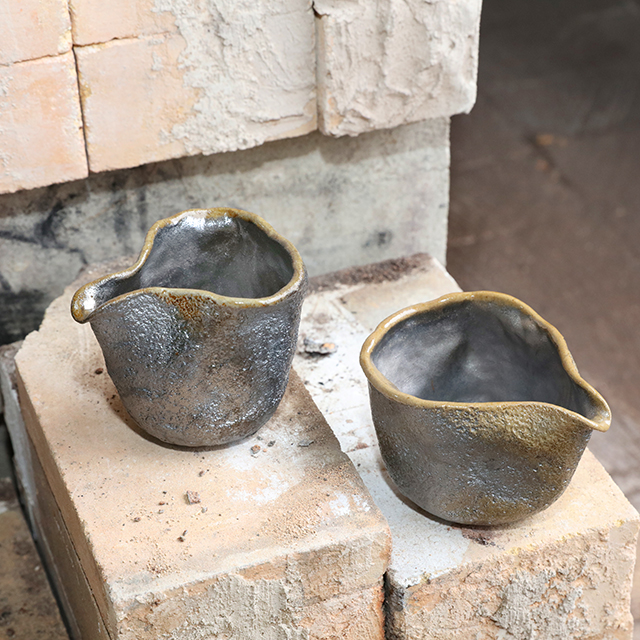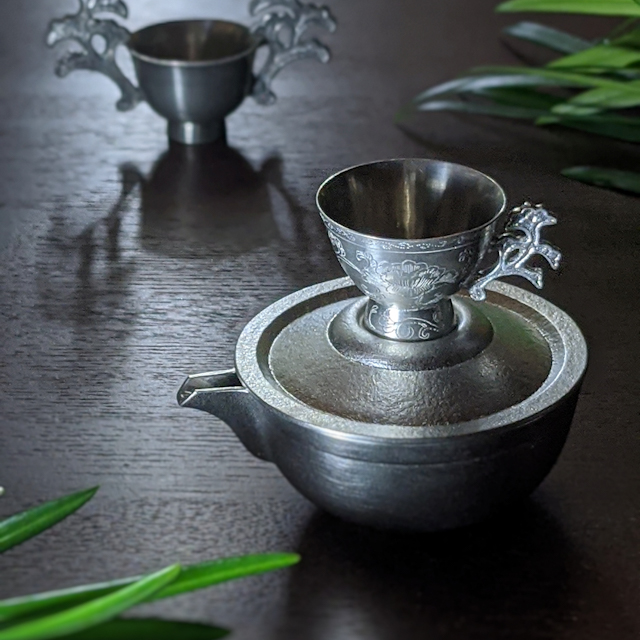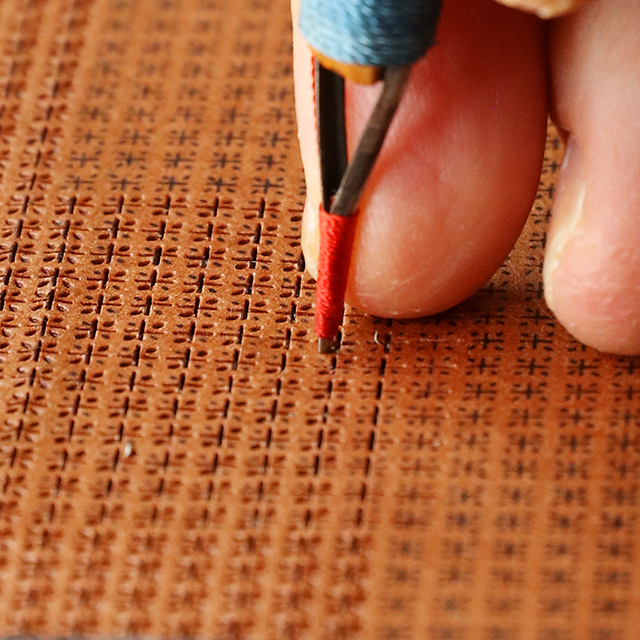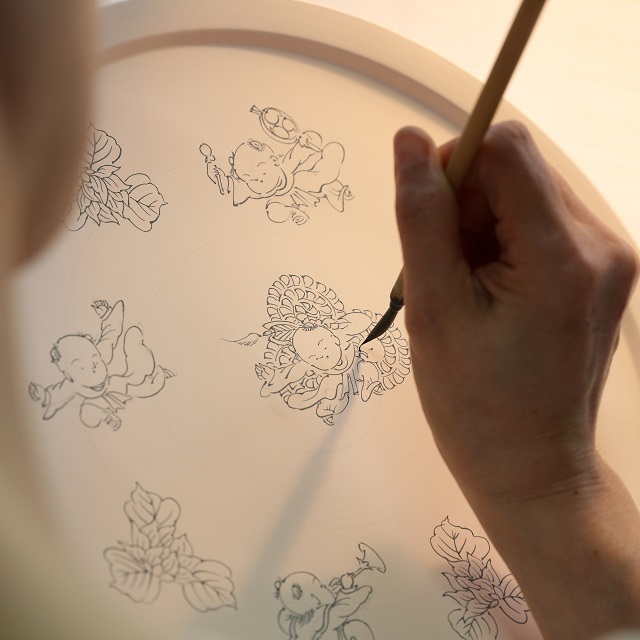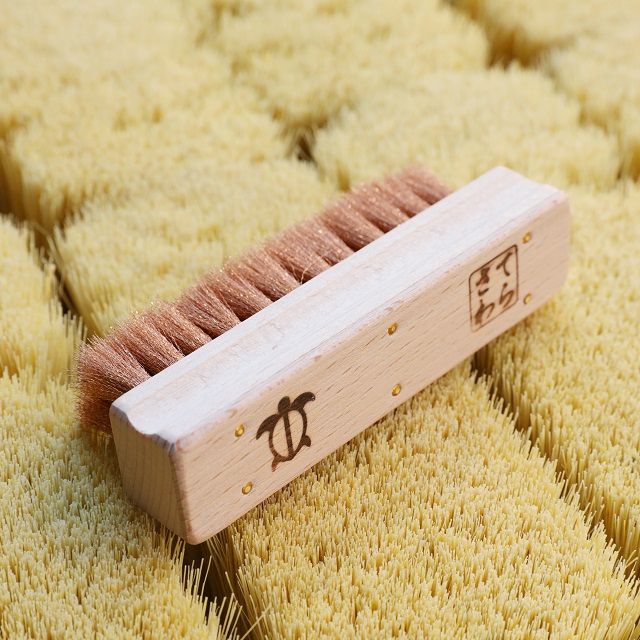One day, I visited a gallery in Ginza where a solo exhibition of Bizen ware was being held.
While I was casually looking at the work, a wild-looking man with long hair tied back and a beard appeared at the entrance, saying cheerfully, I am back! When I locked eyes with him, he smiled and said, “Do you like Bizen Pottery? He smiled again and said, “Do you like Bizen Pottery?” He was Mr. Seigo Matsuoka, a Bizen Pottery artist.
I said, “I have been thinking of getting a Bizen ware coffee cup one of these days.” Matsuoka-san showed me a coffee cup with a scarlet pattern on its light brown surface with a Hidasuki (a fire decoration). When I held it in my hand, it fit surprisingly comfortably.
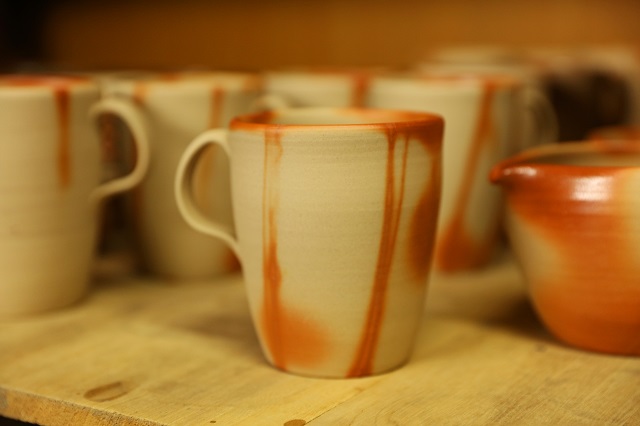
A coffee cup made by Ju Matsuoka with a hidasuki.
“The handle is a little small, isn’t it? Many Japanese coffee cup shapes of foreign ones, but this one was made to fit Japanese hands. The index and middle fingers are put in a cup handle, and the ring finger is used to support the cup. That way, it won’t slip down and you can relax while drinking from it.
Amazed success rate of Rare and valuable Kurobizen cups to be fired in the kilns is 50%.
 A multiple purpose cup like lava. No glaze is used a tall.
A multiple purpose cup like lava. No glaze is used a tall.
He then pointed to a black cup with a metallic shine asking” look at this please.” There was one with a texture like lava stone and another with a stylish beveled edge.
“This is known as “hikidashi(drawer)Kurobizen,” a technique in which vessels are pulled out of the kiln at a high temperature during firing and then cooled down rapidly. Normally, most of the pieces are broken during the rapid cooling process, and only about 5% remain. However, I have raised that percentage to 50%. That’s why I can keep the price down. People are often surprised that I can offer them at such affordable prices.”
I was immediately fascinated by the lava-like texture of the hikidashi Kurobizen. Looking inside, the smooth skin like surface shone sensually silvery black in the light, different from the matte like outside. When you hold it in your hand, there is an indentation that is so subtle that you cannot see it with your eyes, but your thumb, middle finger, and ring finger fit easily into it, and it seems to be comfortably absorbed into your hand.
After much deliberation about the Hidasuki coffee cup, I ended up buying the hikidashi Kurobizen a multiple -purpose cup. To be honest, I was curious to buy it and try it out since if I could get such a rare Kurobizen drawer at this price.
However, I also wondered if the price should not be lowered because the success rate was good, given the high level of technology, design, and his thought that went into every detail regarding usability. Such a question also came to mind.
I wanted to learn more about Matsuoka’s craftsmanship and his way of thinking, so I decided to visit his workshop in Bizen City, Okayama Prefecture.
The kiln was designed and built by Mr. Matsuoka, who calculated the burning conditions, combustion efficiency, as well as other factors.
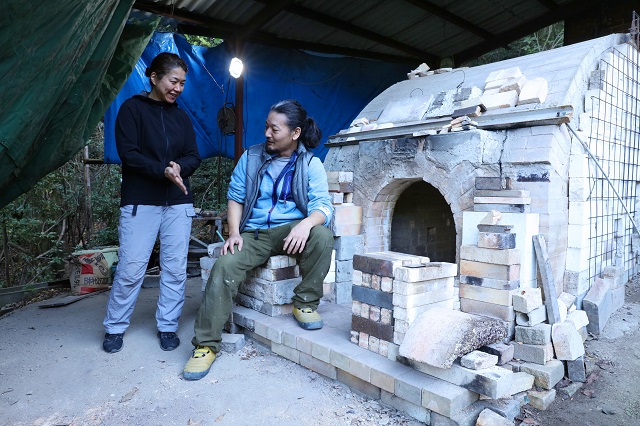
Seigo Matsuoka and his wife, Ayumi. In front of the kiln.
Two weeks later, we visited Mr. Matsuoka’s studio in a remote mountain area of Bizen City. There was a hut with a potter’s wheel and one large and one small kiln. He and his wife, Ayumi, also a Bizen potter, greeted me and showed me around the small kiln.
“She(kiln) works very hard,” he said. She works very hard,” Ayumi said, gently patting the small kiln.”
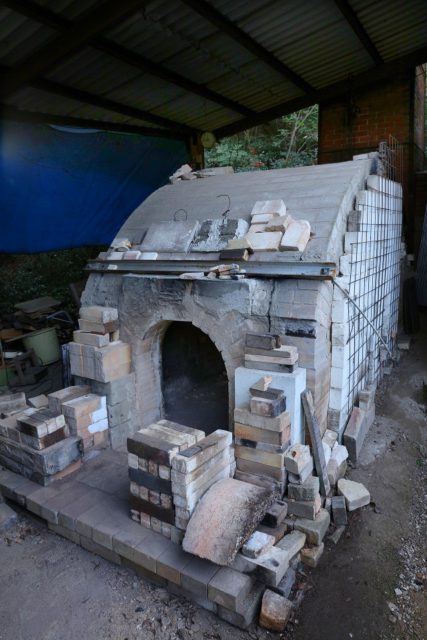 Special heat-resistant bricks are stacked on top of each other.
Special heat-resistant bricks are stacked on top of each other.
“This kiln has a shape that is rare in Bizen, but it is quite good. I calculated the burning conditions and combustion efficiency, and drew a blueprint for the kiln. There are many uncertain factors such as location, climate, and fuel, so it is impossible to make a kiln score100-points out of 100, so we aimed for about 60 points. The other 40 points can be covered by skillmanship.” says Matsuoka. They made both large and small kilns by themselves.
The small kilns have the reason because they were able to increase the percentage of taking out hikidashi Kurobizen from the kiln. He says, “We were able to fire small quantities of each piece and experiment with them over and over again.
In the end, it’s all about why it cracks,” he says. By looking at the cracks, you can tell what happened. Once you know the cause, you can stop doing it. We improved the accuracy through trial and error. As a graduate of a science university, analysis of Chemistry is also his specialty. Even so, it took seven years to reach a 50% kiln removal rate.
I can’t raise the price of my work because I want more people to know what is good quality.
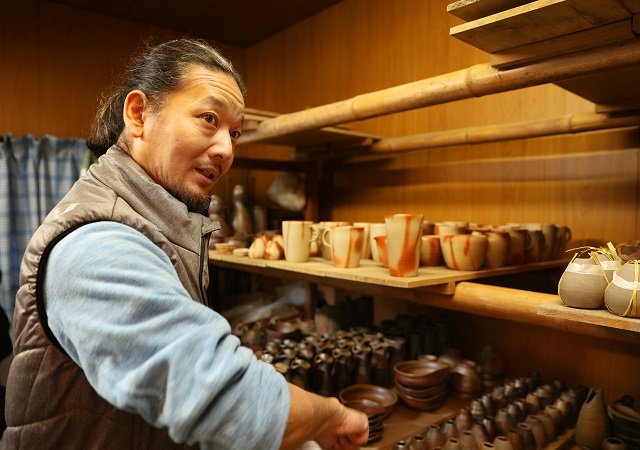 In front of the freshly baked vessels, The next day, Mr. Matsuoka left for Nanki-Shirahama with some kind of his work.
In front of the freshly baked vessels, The next day, Mr. Matsuoka left for Nanki-Shirahama with some kind of his work.
No one else compare to the 50% completion rate of the hikidashi Kurobizen. It has taken a lot of time and effort to get to this point. If that is the case, it should be acceptable to sell them at a reasonable price. I asked frankly Mr. Matsuoka about it.
“I want to do a valuable job. The price is determined by the calculation of how much it costs, the taking out success, and how much profit is made. We can survive even if we don’t make a lot of money, and our customers can get good products at low prices. Both parties are happy. If I boast that my work is very good because only I can do it, the balance would still be upset. I think there is a limit between creator and customer.
For example, if the price of Chinese cabbage soared, people would refrain from buying it. It is only a difference of a few tens of yen. When the price of Chinese cabbage is high ,people buy less even if it is only a few tens of yen. I can’t raise the price for my work because if people don’t use it, they lose the chance to see how good it is.
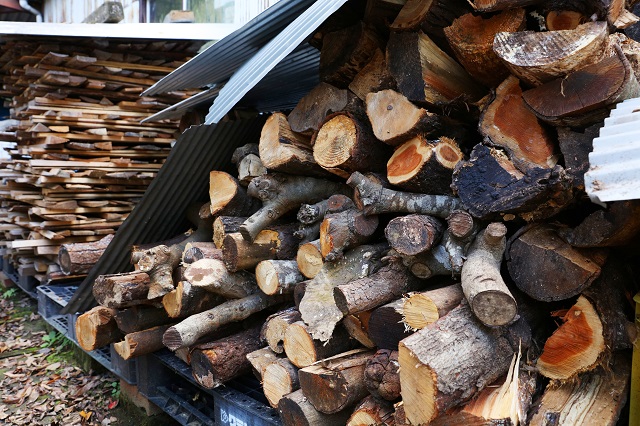 They also chop their own firewood. If you buy good firewood, it doesn’t take much time and effort, but they are willing to spare no expense to keep the selling price as low as possible.
They also chop their own firewood. If you buy good firewood, it doesn’t take much time and effort, but they are willing to spare no expense to keep the selling price as low as possible.
“But if you get it right, you will never lose your livelihood,” he says. “In the first place, I am happy to be able to do what I want to do and have food on the table. It doesn’t matter whether prices go up and down because I don’t know what will happen after I sell may work. If the work becomes popular, and the demand for my work exceed supply then I just think that the work is the worth being appreciated. I don’t think taste is something you decide for yourself, but something others decide for it.
Thoroughly crafting the parts that cannot be seen from the outside
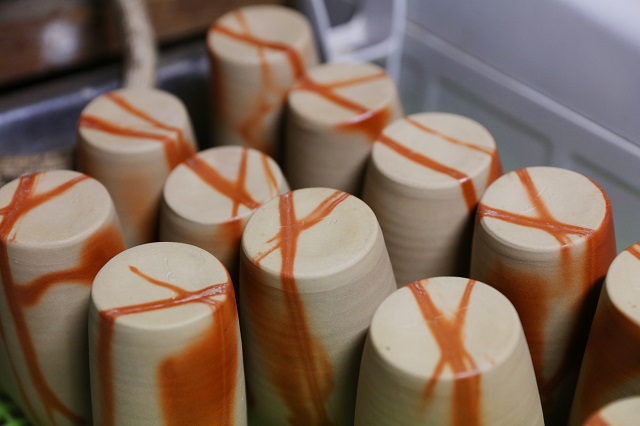 You may not recognize its elaborateness from outside but the design is balanced at three points to prevent rattling
You may not recognize its elaborateness from outside but the design is balanced at three points to prevent rattling
“What he does is really simple and hard to understand. For example, flower vases and tableware are made to be supported at three points so that they do not rattle. You can’t realize unless you look closely, but he always does this.
It’s a very subtle thing that you can’t see from the outside, but we make sure it’s thoroughly crafted to the point where you can tell when it’s up par,” says Ayumi.
“We really don’t want something that looks cool but rattles. It might be true to say that the marks made by hand can also be a part of the style. But if they are unintentional, I want to erase them. Bizen ware does not use glaze, so even the slightest thing stands out.
It is the same with cars. If someone says, “The paint is peeling, but the performance is good,” you still can’t buy it. And say, “Yes, but it still doesn’t meet my standards.”
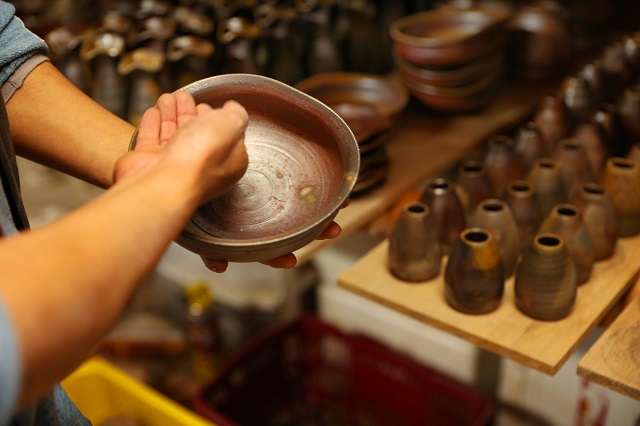 The small bowl has a folded out lip. This allows you to scoop all of the cooked beans with a spoon until the very end.
The small bowl has a folded out lip. This allows you to scoop all of the cooked beans with a spoon until the very end.
In addition, he pursues the beauty of each bowl according to its function. For example, “A large bowl should be heavy so that it does not move when you scoop food,” or “A kataguchi should be beautifully curved at the wrist when a woman holds it in her hand. “I want make things like that, he says. These are vessels that you use them despite their high or low price, aren’t they?I want to make people feel attached containers so they feel moved if they are broken.
It is also important for me to talk about my work so that people will use it.
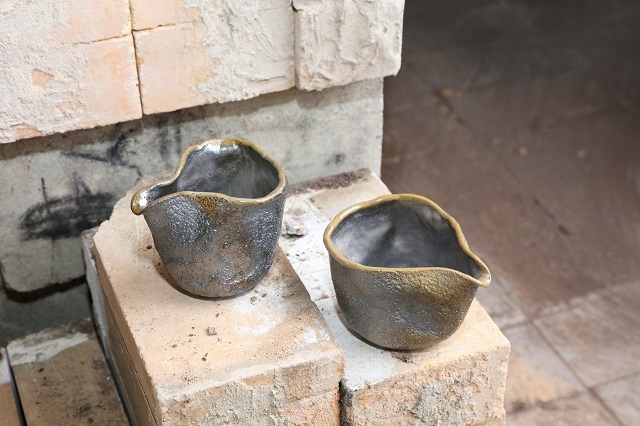
Hikidashi Kurobizen. Depending on the temperature, the color changes from blackish to silverish.
The true value of Matsuoka’s containers can only be appreciated by using them. However, he not only
passively waits saying “You will understand it when you use it,” but he also places an importance on conveying its quality to the user. He travels around the country himself, talking about his work and Bizen ware.
“Everywhere I go, I talk all day long, to the surprise of galleries. Sometimes I am even mistaken for a vendor (laughs).
When people think of Bizen ware, they tend to just say, ‘Oh, it’s expensive,’ but there is a reason why it is so expensive. It takes much more time and cost. When I explain this in detail to people, they understand that it is a natural thing,” says Matsuoka.
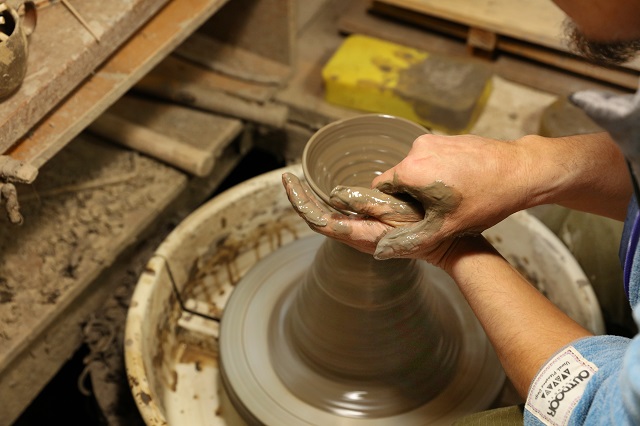 He never stops talking even while pulling the potter’s wheel. Matsuoka’s hands move freely and precisely even as he talks.
He never stops talking even while pulling the potter’s wheel. Matsuoka’s hands move freely and precisely even as he talks.
He has time to sell his work by himself because, Matsuoka says, “Whether it’s good or bad, it’s because I can do it quickly”. He originally worked as a potter for a company, so he had to make 500 or 1,000 pieces of the same item on a potter’s wheel. That is where he developed the skill to make things quickly and accurately.
“I became so good at it. But may works was indistinguishable from the work of its others on the job. I was worried about losing my independence so I decided to out on my own ”. He nostalgically talked about his story.
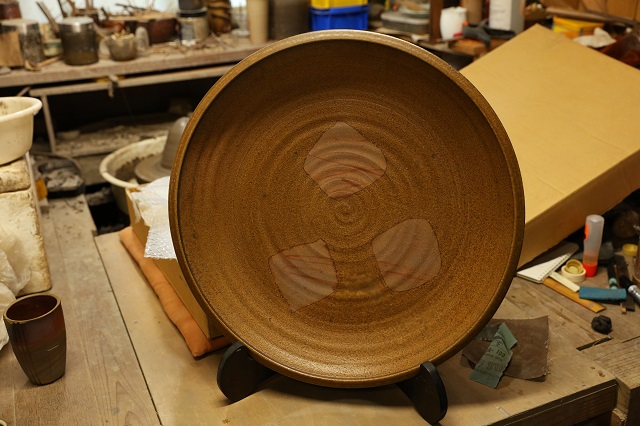
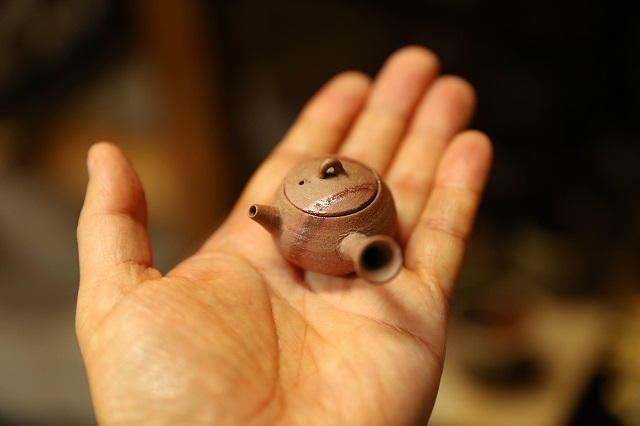
Both the large plates and the small teapot are made by hand using a potter’s wheel.
Craftsman’s hands that tell the story of his way of life.
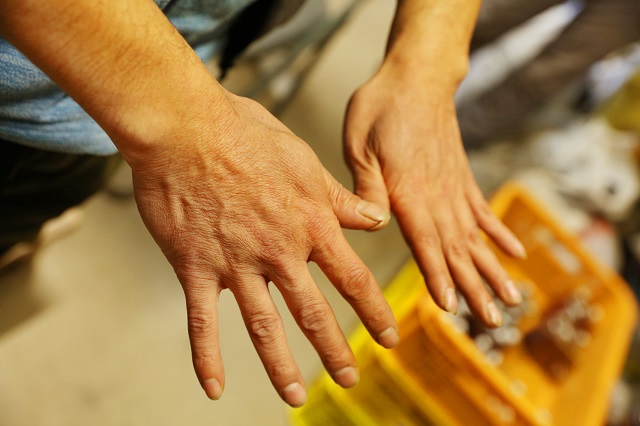
Matsuoka’s hands. It is said that people who work on the potter’s wheel have thick hands.
I was surprised to hear that the bulge at the base of the thumb is a muscle!
Looking at Masuoka’s hand, the base of the thumb has a raised like hump. It is a very flexible muscle that is soft to the touch and is used to hold the fingers in place. The “bump” is soft to the touch and very supple. The muscle is used to hold the fingers in place, and they developed over the years as he continued to work on the wheel.
“My fingers too all work in pieces like a pianist. That is why I can do with one hand what normally would take four fingers. This is another secret to saving time. My thumbnail is also long because I use it as a tool. If you cut it off, you can’t make some things, such as ceramic lids”.
What is engraved on this hand is the accumulation of many years.
It seems to tell the story of all his thoughts and experiences, and it is very precious and beautiful to the eye.
Interviewed by Seigo Matsuoka (Bizen Pottery)
Photography: Takahiro Suwa (Sakurado)
Writing: Yuko Setoguchi
Translator:Makoto Uchida







